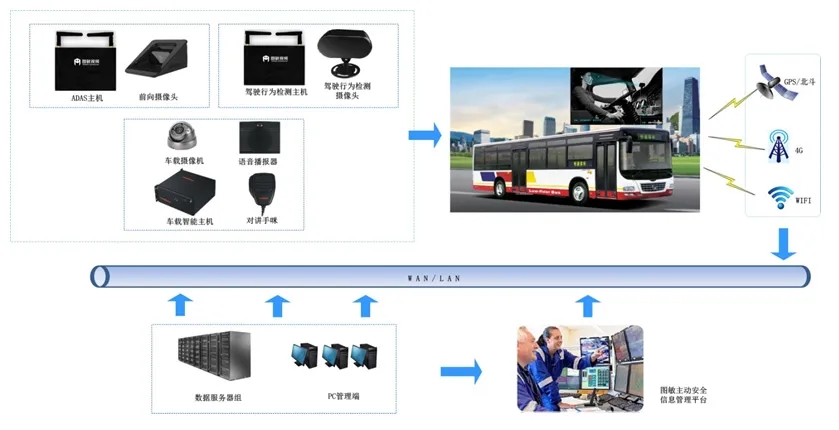【Technology】Application of vehicle-mounted monitoring system in dangerous goods transportation industry
2022-08-16 Author:BRVISION
【Technology】Application of vehicle-mounted monitoring system in dangerous goods transportation industry
With the rapid growth of the international economy, oil, natural gas, etc., as important industrial products for economic operation, are more and more widely used in industrial production and people’s lives. Transportation is an important link in the circulation process of dangerous goods such as oil and natural gas, which is highly fluid, difficult to manage, and has greater risks. The frequent occurrence of hazardous chemical transportation accidents shows that there are still major loopholes and deficiencies in the technical supervision of hazardous chemical transportation. Reports of car accidents and leakage accidents of dangerous goods transport vehicles on highways and national highways frequently broadcast by international media have sounded the alarm for the transport of dangerous goods. How to supervise dangerous goods transportation vehicles has always been a problem that the dangerous goods transportation industry needs to attach great importance to and needs to be solved urgently.
Dangerous goods transportation monitoring solution
In recent years, with the popularization of vehicle-mounted monitoring, various dangerous goods transportation enterprises have adopted "vehicle-mounted embedded monitoring + vehicle driving recorder" to strengthen the whole-process monitoring of dangerous goods transportation vehicles, so as to solve the problems from dispatching to transportation monitoring, and A series of safety supervisions such as the supervision and management of drivers; combined with the GIS/GPS global satellite positioning system, it can effectively monitor the transportation process, reduce the safety hazards of dangerous goods transportation, and solve many problems in the safe transportation of dangerous goods.
 In view of the current situation of the dangerous goods transportation industry, it is a better solution to choose the vehicle-mounted monitoring system. The vehicle-mounted monitoring system integrates the embedded vehicle-mounted digital video processing system, vehicle driving record system, GPRS/CDMA mobile communication network system and GIS/GPS global satellite positioning. It can realize effective monitoring, emergency rescue and provide various information services for mobile targets with strong mobility across regions.
In view of the current situation of the dangerous goods transportation industry, it is a better solution to choose the vehicle-mounted monitoring system. The vehicle-mounted monitoring system integrates the embedded vehicle-mounted digital video processing system, vehicle driving record system, GPRS/CDMA mobile communication network system and GIS/GPS global satellite positioning. It can realize effective monitoring, emergency rescue and provide various information services for mobile targets with strong mobility across regions.
The vehicle monitoring system consists of three parts: the vehicle video monitoring and video recording system, the wireless data transmission system (including GPRS/CDMA audio and video transmission and GPS global satellite positioning), and the central control management system. As long as the satellite signal covers the place, the moving target can be realized Effective tracking, monitoring and management.
Vehicle monitoring features
1. Real-time monitoring of the transportation process of dangerous goods: The vehicle-mounted embedded monitoring system can realize real-time monitoring of multiple information. The vehicle-mounted driving record terminal reports the vehicle’s driving status and real-time location and other information in real time according to preset time intervals, and the monitoring center automatically monitors the reported information. For processing and storage, it is possible to understand the driving status and operating environment of dangerous goods vehicles in real time, and timely discover environmental or human problems, including random parking, irrelevant rides, etc.
2. Information inquiry during transportation: You can inquire about the information of dangerous goods and highly toxic chemicals production and transportation enterprises at any time, the release of laws and regulations concerning the management of highly toxic chemicals, and the list of highly toxic chemicals. You can check the name of the consignor, the name of the transportation unit and the transportation route, the transportation vehicles and transportation personnel, the name and quantity of the highly toxic chemicals being transported, and the validity period of the relevant road transportation passes.
3. Emergency linkage of emergency events: including traffic control at the accident site, evacuation of people around the accident site, emergency rescue of the accident, etc. The relevant information can be sent to the monitoring and command center in real time to facilitate the timely handling of the accident.
4. Information processing after transportation: After the vehicle arrives at the destination, the vehicle tachograph and video files can be downloaded and inquired through the wired/wireless network. Stored images and data information can be printed and played back for easy checking of vehicle running trajectories and system operation logs.
5. Whole-process positioning monitoring of transportation: Through GIS/GPS geographic information/satellite positioning system, the positioning signal can be transmitted to the vehicle monitoring and dispatching center. The monitoring and dispatching center converts the position information through differential technology, and then displays the position signal in the map language through GIS to realize the functions of vehicle positioning and navigation, service and rescue trajectory recording, etc.
6. Alarm function: The vehicle-mounted embedded host can be connected to any conventional alarm detection equipment. When an alarm occurs, the alarm information will be transmitted to the monitoring center, and the icon corresponding to the vehicle will not stop on the GIS map of the monitoring center. Flashing, the monitoring personnel click the icon corresponding to the vehicle with the mouse, and the information of the vehicle (such as license plate number, driving route, etc.) and driver information (such as name, age, driving age, etc.) will be automatically displayed. The video signal corresponding to the vehicle will be transmitted to the monitoring center through GPRS or CDMA, and the monitoring personnel can immediately monitor the vehicle remotely. Combined with GPS and electronic maps, the police can immediately know the location of the vehicle and quickly dispatch the police accordingly.
The composition of the vehicle monitoring system
The system consists of three parts: vehicle surveillance video system, data transmission system (CDMA/GPRS/GPS), central control management system
1. Vehicle monitoring system
The vehicle monitoring system is installed on the dangerous goods transport vehicle, and its main functions are vehicle operation monitoring, video recording and wireless data transmission. The system installs 2 to 4 infrared color (or black and white) pinhole cameras in the cab and the rear of the dangerous goods vehicle, so that the scene can be clearly seen at night without light.
Because the dangerous goods transport vehicle is in a moving state, and the temperature and humidity change greatly, there is a lot of dust, and the working environment is harsh, so the requirements for digital video recorders are relatively high. The vehicle monitoring host selected in this scheme adopts embedded RTOS operating system, which has the characteristics of system stability and powerful functions. The chassis structure adopts professional anti-vibration design and multiple hard disk protection measures; it has the function of synchronous recording of vehicle speed, driving route, driving status, etc. with real-time images; its overspeed alarm function can record driving information related to vehicle speed, steering, braking and parking time, etc. The video data is stored in H.264 compression format, and has many characteristics such as clear image, small space occupation and network transmission bandwidth.
In addition, due to the large voltage change of automotive electrical equipment and strong electromagnetic interference, this vehicle embedded host has a wide input voltage range, and the host can maintain normal operation when the input voltage is within the range of DC7V ~ 30V, and the output voltage will remain unchanged. The change ensures the normal power supply to the monitor and the camera, and the monitoring image can remain clear and stable during the entire driving process of the car, which not only improves the service life of the monitor and the camera, but also ensures stable image quality.
2. Data transmission system
In addition to the monitoring and video recording of the vehicle, the system can transmit the audio and video of the vehicle and related vehicle information to the monitoring center in real time through the GPRS or CDMA module in conjunction with the wireless digital transmission module, so as to realize the remote audio and video of the dangerous goods transportation vehicle. and driving monitoring.
3. Central monitoring and management system
The central monitoring and management system mainly includes the vehicle monitoring and management server and the corresponding supervision software. Its main functions are:
Receiving and storage: The server receives and stores the audio and video images uploaded by the wireless digital transmitter on the dangerous goods transport vehicle and the relevant information on the vehicle driving recorder.
Driver and vehicle management: The server can store and manage the information of dangerous goods transport vehicles and drivers by downloading the data on the video recorder, including the driver’s name, age, driving record, license plate, model, affiliated unit and other related information. In this way, when monitoring the transport vehicle in real time, the relevant information of the driver and the vehicle can be accessed at any time. Managers can easily add, modify, delete, query these data.
In addition, managers can back up the audio and video data recorded on the vehicle embedded host to the computer through various methods, such as wireless bridges, ordinary networks, etc.
The central server in this solution has the function of networking and can centrally manage the servers distributed in various places. For the video data backed up on the server, you can query by specifying the time, license plate number and other conditions.
The system can also realize the precise positioning of the electronic map by using the GIS/GPS module, and can realize the seamless coverage of the national electronic map and provide real-time monitoring of inter-provincial transportation. While displaying the video image of the transport vehicle, the central control room can also display the GPS location information of the vehicle on the electronic map. When an emergency occurs in the vehicle, it is convenient for the relevant departments to rush to the scene to deal with it.
With the rapid growth of the international economy, oil, natural gas, etc., as important industrial products for economic operation, are more and more widely used in industrial production and people’s lives. Transportation is an important link in the circulation process of dangerous goods such as oil and natural gas, which is highly fluid, difficult to manage, and has greater risks. The frequent occurrence of hazardous chemical transportation accidents shows that there are still major loopholes and deficiencies in the technical supervision of hazardous chemical transportation. Reports of car accidents and leakage accidents of dangerous goods transport vehicles on highways and national highways frequently broadcast by international media have sounded the alarm for the transport of dangerous goods. How to supervise dangerous goods transportation vehicles has always been a problem that the dangerous goods transportation industry needs to attach great importance to and needs to be solved urgently.
Dangerous goods transportation monitoring solution
In recent years, with the popularization of vehicle-mounted monitoring, various dangerous goods transportation enterprises have adopted "vehicle-mounted embedded monitoring + vehicle driving recorder" to strengthen the whole-process monitoring of dangerous goods transportation vehicles, so as to solve the problems from dispatching to transportation monitoring, and A series of safety supervisions such as the supervision and management of drivers; combined with the GIS/GPS global satellite positioning system, it can effectively monitor the transportation process, reduce the safety hazards of dangerous goods transportation, and solve many problems in the safe transportation of dangerous goods.

The vehicle monitoring system consists of three parts: the vehicle video monitoring and video recording system, the wireless data transmission system (including GPRS/CDMA audio and video transmission and GPS global satellite positioning), and the central control management system. As long as the satellite signal covers the place, the moving target can be realized Effective tracking, monitoring and management.
Vehicle monitoring features
1. Real-time monitoring of the transportation process of dangerous goods: The vehicle-mounted embedded monitoring system can realize real-time monitoring of multiple information. The vehicle-mounted driving record terminal reports the vehicle’s driving status and real-time location and other information in real time according to preset time intervals, and the monitoring center automatically monitors the reported information. For processing and storage, it is possible to understand the driving status and operating environment of dangerous goods vehicles in real time, and timely discover environmental or human problems, including random parking, irrelevant rides, etc.
2. Information inquiry during transportation: You can inquire about the information of dangerous goods and highly toxic chemicals production and transportation enterprises at any time, the release of laws and regulations concerning the management of highly toxic chemicals, and the list of highly toxic chemicals. You can check the name of the consignor, the name of the transportation unit and the transportation route, the transportation vehicles and transportation personnel, the name and quantity of the highly toxic chemicals being transported, and the validity period of the relevant road transportation passes.
3. Emergency linkage of emergency events: including traffic control at the accident site, evacuation of people around the accident site, emergency rescue of the accident, etc. The relevant information can be sent to the monitoring and command center in real time to facilitate the timely handling of the accident.
4. Information processing after transportation: After the vehicle arrives at the destination, the vehicle tachograph and video files can be downloaded and inquired through the wired/wireless network. Stored images and data information can be printed and played back for easy checking of vehicle running trajectories and system operation logs.
5. Whole-process positioning monitoring of transportation: Through GIS/GPS geographic information/satellite positioning system, the positioning signal can be transmitted to the vehicle monitoring and dispatching center. The monitoring and dispatching center converts the position information through differential technology, and then displays the position signal in the map language through GIS to realize the functions of vehicle positioning and navigation, service and rescue trajectory recording, etc.
6. Alarm function: The vehicle-mounted embedded host can be connected to any conventional alarm detection equipment. When an alarm occurs, the alarm information will be transmitted to the monitoring center, and the icon corresponding to the vehicle will not stop on the GIS map of the monitoring center. Flashing, the monitoring personnel click the icon corresponding to the vehicle with the mouse, and the information of the vehicle (such as license plate number, driving route, etc.) and driver information (such as name, age, driving age, etc.) will be automatically displayed. The video signal corresponding to the vehicle will be transmitted to the monitoring center through GPRS or CDMA, and the monitoring personnel can immediately monitor the vehicle remotely. Combined with GPS and electronic maps, the police can immediately know the location of the vehicle and quickly dispatch the police accordingly.
The composition of the vehicle monitoring system
The system consists of three parts: vehicle surveillance video system, data transmission system (CDMA/GPRS/GPS), central control management system
1. Vehicle monitoring system
The vehicle monitoring system is installed on the dangerous goods transport vehicle, and its main functions are vehicle operation monitoring, video recording and wireless data transmission. The system installs 2 to 4 infrared color (or black and white) pinhole cameras in the cab and the rear of the dangerous goods vehicle, so that the scene can be clearly seen at night without light.
Because the dangerous goods transport vehicle is in a moving state, and the temperature and humidity change greatly, there is a lot of dust, and the working environment is harsh, so the requirements for digital video recorders are relatively high. The vehicle monitoring host selected in this scheme adopts embedded RTOS operating system, which has the characteristics of system stability and powerful functions. The chassis structure adopts professional anti-vibration design and multiple hard disk protection measures; it has the function of synchronous recording of vehicle speed, driving route, driving status, etc. with real-time images; its overspeed alarm function can record driving information related to vehicle speed, steering, braking and parking time, etc. The video data is stored in H.264 compression format, and has many characteristics such as clear image, small space occupation and network transmission bandwidth.
In addition, due to the large voltage change of automotive electrical equipment and strong electromagnetic interference, this vehicle embedded host has a wide input voltage range, and the host can maintain normal operation when the input voltage is within the range of DC7V ~ 30V, and the output voltage will remain unchanged. The change ensures the normal power supply to the monitor and the camera, and the monitoring image can remain clear and stable during the entire driving process of the car, which not only improves the service life of the monitor and the camera, but also ensures stable image quality.
2. Data transmission system
In addition to the monitoring and video recording of the vehicle, the system can transmit the audio and video of the vehicle and related vehicle information to the monitoring center in real time through the GPRS or CDMA module in conjunction with the wireless digital transmission module, so as to realize the remote audio and video of the dangerous goods transportation vehicle. and driving monitoring.
3. Central monitoring and management system
The central monitoring and management system mainly includes the vehicle monitoring and management server and the corresponding supervision software. Its main functions are:
Receiving and storage: The server receives and stores the audio and video images uploaded by the wireless digital transmitter on the dangerous goods transport vehicle and the relevant information on the vehicle driving recorder.
Driver and vehicle management: The server can store and manage the information of dangerous goods transport vehicles and drivers by downloading the data on the video recorder, including the driver’s name, age, driving record, license plate, model, affiliated unit and other related information. In this way, when monitoring the transport vehicle in real time, the relevant information of the driver and the vehicle can be accessed at any time. Managers can easily add, modify, delete, query these data.
In addition, managers can back up the audio and video data recorded on the vehicle embedded host to the computer through various methods, such as wireless bridges, ordinary networks, etc.
The central server in this solution has the function of networking and can centrally manage the servers distributed in various places. For the video data backed up on the server, you can query by specifying the time, license plate number and other conditions.
The system can also realize the precise positioning of the electronic map by using the GIS/GPS module, and can realize the seamless coverage of the national electronic map and provide real-time monitoring of inter-provincial transportation. While displaying the video image of the transport vehicle, the central control room can also display the GPS location information of the vehicle on the electronic map. When an emergency occurs in the vehicle, it is convenient for the relevant departments to rush to the scene to deal with it.
Previous:The principle and structure of the car camera
Next:Which is more reliable, reversing camera or radar? How to operate more safely when reversing?
Latest News
- Enhance Fleet Safety and Efficiency with the 2023 Iveco Daily Brake Light Camera2025-08-27
- See Clearly, Operate Safely: BRvision’s Heavy-Duty Camera Solutions2025-08-27
- 1TB Mobile SD video Recorder: The all-round guardian for security and driving2025-08-27
- New-generation 360 Degree Full HD Bird-View System2025-08-27
- Premium 7" Quad-Split Monitor for Superior Vehicle Monitoring2025-07-31
- Your Unbreakable 7" Vision Partner for Harsh Environments2025-07-31
- 9 INCH HD Quad Split Monitor2025-07-22
- Introducing the MNC04: Your Ultimate Compact Vision Solution for Tight Spaces!2025-07-22
- Tired of those nerve - wracking blind spots and constant visibility woes when operating trailers, mining trucks, or other heavy - duty construction vehicles?2025-07-22
- Brvision Makes Waves at Automechanika Istanbul 20252025-07-12
Copyright © 2025 Brivision-All rights reserved




